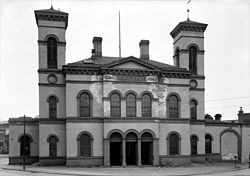 | |
 Calvert Street Station at North Calvert and Bath/East Franklin Streets, in downtown Baltimore, built 1849-1850, razed 1949; designed by James Crawford Neilson | |
| Overview | |
|---|---|
| Headquarters | Baltimore |
| Reporting mark | NCRY |
| Locale | Pennsylvania and Maryland |
| Dates of operation | 1858–1976 |
| Predecessor | Baltimore and Susquehanna Railroad, York and Maryland Line Rail Road, Susquehanna Railroad |
| Successor | Conrail |
| Technical | |
| Track gauge | 4 ft 8+1⁄2 in (1,435 mm) standard gauge |
| Length | 380 miles (610 km) (including leased lines)[1] |
Northern Central Railway | ||||||||||||||||||||||||||||||||||||||||||||||||||||||||||||||||||||||||||||||||||||||||||||||||||||||||||||||||||||||||||||||||||||||||||||||||||||||||||||||||||||||||||||||||||||||||||||||||||||||||||||||||||||||||||||||||||||||||||||||||||||||||||||||||||||||||||||||||||||||||||||||||||||||||||||||||||||||||||||||||||||||||||||||||||||||||||||||||||||||||||||||||||||||||||||||||||||||||||||
|---|---|---|---|---|---|---|---|---|---|---|---|---|---|---|---|---|---|---|---|---|---|---|---|---|---|---|---|---|---|---|---|---|---|---|---|---|---|---|---|---|---|---|---|---|---|---|---|---|---|---|---|---|---|---|---|---|---|---|---|---|---|---|---|---|---|---|---|---|---|---|---|---|---|---|---|---|---|---|---|---|---|---|---|---|---|---|---|---|---|---|---|---|---|---|---|---|---|---|---|---|---|---|---|---|---|---|---|---|---|---|---|---|---|---|---|---|---|---|---|---|---|---|---|---|---|---|---|---|---|---|---|---|---|---|---|---|---|---|---|---|---|---|---|---|---|---|---|---|---|---|---|---|---|---|---|---|---|---|---|---|---|---|---|---|---|---|---|---|---|---|---|---|---|---|---|---|---|---|---|---|---|---|---|---|---|---|---|---|---|---|---|---|---|---|---|---|---|---|---|---|---|---|---|---|---|---|---|---|---|---|---|---|---|---|---|---|---|---|---|---|---|---|---|---|---|---|---|---|---|---|---|---|---|---|---|---|---|---|---|---|---|---|---|---|---|---|---|---|---|---|---|---|---|---|---|---|---|---|---|---|---|---|---|---|---|---|---|---|---|---|---|---|---|---|---|---|---|---|---|---|---|---|---|---|---|---|---|---|---|---|---|---|---|---|---|---|---|---|---|---|---|---|---|---|---|---|---|---|---|---|---|---|---|---|---|---|---|---|---|---|---|---|---|---|---|---|---|---|---|---|---|---|---|---|---|---|---|---|---|---|---|---|---|---|---|---|---|---|---|---|---|---|---|---|---|---|---|---|---|---|---|---|---|---|---|---|---|---|---|---|---|---|---|---|---|---|---|---|---|---|---|---|---|---|---|---|---|---|---|---|---|---|---|---|---|---|
| ||||||||||||||||||||||||||||||||||||||||||||||||||||||||||||||||||||||||||||||||||||||||||||||||||||||||||||||||||||||||||||||||||||||||||||||||||||||||||||||||||||||||||||||||||||||||||||||||||||||||||||||||||||||||||||||||||||||||||||||||||||||||||||||||||||||||||||||||||||||||||||||||||||||||||||||||||||||||||||||||||||||||||||||||||||||||||||||||||||||||||||||||||||||||||||||||||||||||||||
The Northern Central Railway (NCRY) was a Class I Railroad in the United States connecting Baltimore, Maryland, with Sunbury, Pennsylvania, along the Susquehanna River. Completed in 1858, the line came under the control of the Pennsylvania Railroad (PRR) in 1861, when the PRR acquired a controlling interest in the Northern Central's stock to compete with the rival Baltimore and Ohio Railroad (B&O).
For eleven decades, the Northern Central operated as a subsidiary of the Pennsylvania Railroad until much of its Maryland trackage was washed out by Hurricane Agnes in 1972, after which the Penn Central declined to repair destroyed sections and the remainder fell into disuse. It is now a fallen flag railway, having come under the control of Conrail and then the Norfolk Southern Railway.
Trackage from Camden Station in Baltimore to Timonium, Maryland, remains in service as part of the Baltimore Light RailLink line, while much of the line in Pennsylvania is operated by the Norfolk Southern for freight service. The Northern Central Railway of York, a heritage railway, operates on former Northern Central track between New Freedom and Hanover Junction, Pennsylvania.
The route between York, Pennsylvania, and the Maryland-Pennsylvania line is now the York County Heritage Rail Trail, much of which is side-by-side with still-functioning track. Torrey C. Brown Rail Trail, a similar hike/bike trail in Northern Maryland, connects with the York County Heritage Rail Trail and continues down to Baltimore either on rural roads or the old railroad grade.
- ^ Henry Varnum Poor (1900). Poor's Manual of the Railroads of the United States. Vol. 33. New York: H.V. & H.W. Poor. p. 703.